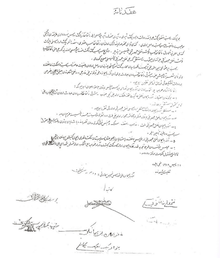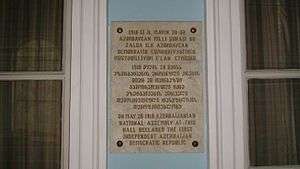Republic Day (Azerbaijan)
Republic Day honours the date on which the Azerbaijan Democratic Republic (ADR) was founded as the first secular democratic state in the Muslim East: 28 May 1918. The founder and the only president of the ADR was Mammad Amin Rasulzadeh.

Since 1990, Republic Day is celebrated as a national holiday in Azerbaijan.[1]
History of Republic Day
The Russian Empire was overthrown by the short-lived February Revolution in 1917. The national movement of people who were trampled by the tyranny existed in the country started. On 28 May 1918 the Azerbaijan Democratic Republic (1918-1920), the first secular democratic state in the Muslim East was proclaimed. The Azerbaijan Democratic Republic, founded by Mammad Amin Rasulzadeh, was the first parliamentary republic and the first democratic, legal and secular state in the Turkish and Islamic world.[2]
.png)

Among the important accomplishments of the ADR was the extension of suffrage to women, making Azerbaijan one of the first countries in the world, and the very first majority-Muslim nation, to grant women equal political rights with men. The first state, which officially recognized the Azerbaijan Democratic Republic was the Ottoman Empire. That historic event took place on 4 June 1918.[3] On 9 November 1918 on the basis of the proposal by Mammad Amin Rasulzadeh the three-color flag of the Azerbaijan Democratic Republic was adopted.[4]
Until then the flag of the Azerbaijan Democratic Republic was red. The Azerbaijan Democratic Republic was able to operate in a tense and complicated socio-political situation for only 23 months. The Soviet Union invaded Azerbaijan on 28 April 1920. Though the idea of independence was not defeated, and in 1991, after the collapse of the Soviet Empire, Azerbaijan again declared its independence.[5][6]
Declaration of Independence
| Declaration of Independence of Azerbaijan | |
|---|---|
 Original text of the Declaration in Azerbaijani | |
| Created | 28 May 1918 |
| Location | National Museum of History of Azerbaijan |
| Signatories | Hasan bey Aghayev, Fatali Khan Khoyski, Nasib Yusifbeyli, Jamo bey Hajinski, Shafi bey Rustambeyli, Nariman bey Narimanbeyov, Javad Malik-Yeganov and Mustafa Mahmudov |
| Purpose | To announce the independence of Azerbaijan |
Azerbaijan declared independence from Russian Empire in Tiflis on 28 May 1918.[7]
The Azerbaijan Democratic Republic was founded by the Azerbaijani National Council in Tiflis on 28 May 1918 after the collapse of the Russian Empire that began with the Russian Revolution of 1917. The Muslim representation in the defunct Transcaucasian Seim had constituted itself into the Azerbaijani National Council, and on 28 May 1918 proclaimed that a new nation was born. So far only a geographical reference, Azerbaijan now became the name of a state, and some 2 million people, called variously Tatars, Transcaucasian Muslims, and Caucasian Turks, officially became Azerbaijanis.[8]
Celebrations
One year after the founding of the ADR, a military parade on the site of the Azerbaijan Carpet Museum took place.[9] In honor of this day the station of the Baku underground is named. Initially, it was called "April 28", since on 28 April 1920, Soviet power was established in Azerbaijan, and the ADR ceased to exist. However, after the Republic gained independence for the second time, the name, reminiscent of the Soviet past, was replaced by "May 28". It was enough to rename only letters, the numbers remained the same.[10]
In honor of this day a street in Baku was named, the Istiglaliyyat Street (Independence Street). On the Istiglaliyyat Street, a stele with the text of the Declaration of Independence (in Arabic and Latin) was installed.
On the wall of the hall of the former palace of the governor in the Caucasus in Tbilisi, where the republic was proclaimed, a memorial plaque with an inscription in Azerbaijani, Georgian and English languages was installed.
In 2008, a postage stamp was issued in connection with the 90th anniversary of the Republic.[11]
- Stella with the text of the Declaration of Independence
 Plaque commemorating the establishment of the Azerbaijan Democratic Republic
Plaque commemorating the establishment of the Azerbaijan Democratic Republic Stamp of Azerbaijan
Stamp of Azerbaijan
See also
References
- Rais Rasulzade (his grandson), "Mammad Amin Rasulzade: Founding Father of the First Republic," in Azerbaijan International, Vol. 7:3 (Autumn 1999), pp. 22-23.
- Tadeusz Swietochowski. Russia and Azerbaijan: A Borderland in Transition. Columbia University Press, 2077. ISBN 0-231-07068-3, ISBN 978-0-231-07068-3 and Reinhard Schulze. A Modern History of the Islamic World. I.B.Tauris, 2000. ISBN 1-86064-822-3, ISBN 978-1-86064-822-9. Citations are at Talk:Azerbaijan Democratic Republic#First or second
- Michael G. Smith. Anatomy of a Rumour: Murder Scandal, the Musavat Party and Narratives of the Russian Revolution in Baku, 1917-20. Journal of Contemporary History, Vol. 36, No. 2 (Apr., 2001), pp. 211–240
- Atabaki, Touraj (2000). Azerbaijan: Ethnicity and the Struggle for Power in Iran. I.B.Tauris. p. 25. ISBN 9781860645549.
- Swietochowski, Tadeusz (2004). Russian Azerbaijan, 1905-1920: The Shaping of a National Identity in a Muslim Community. Cambridge University Press. p. 129. ISBN 0-521-52245-5.
- "The Fate of some of the ADR Parliament Members", Azerbaijan International (7.3) Autumn 1999
- Азербайджанская Демократическая Республика (1918 - 1920). Элм. 1998. p. 316. ISBN 5-8066-0897-2.
- Tadeusz Swietochowski. Russia and Azerbaijan: A Borderland in Transition. New York: Columbia University Press, 1995. ISBN 0231070683, p. 129
- https://news.day.az/society/122461.html
- 125 H.C.Debs., 58., February 24, 1920, p. 1467.
- Kazemzadeh, Firuz (1951). The Struggle for Transcaucasia: 1917-1921. The New York Philosophical Library. pp. 124, 222, 229, 269–270. ISBN 0-8305-0076-6.
| Wikimedia Commons has media related to Declaration of Independence (Azerbaijan). |